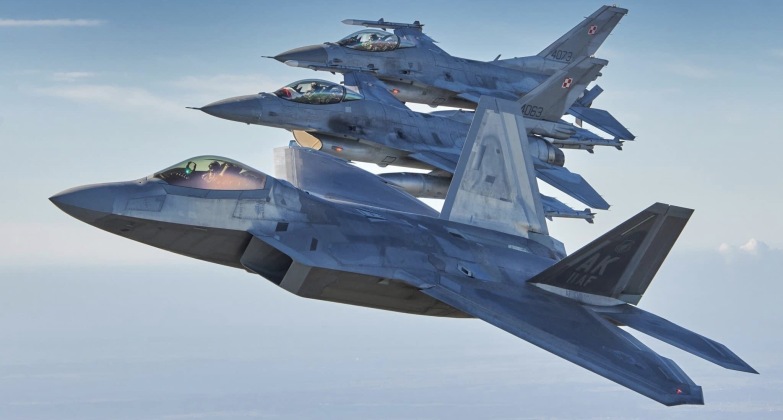News
What Can the F-15EX Fighter Do For Poland? Warsaw Considering Long Range Strike Jets as it Seeks Nuclear Weapons Sharing
The Polish Air Force has shown an interest in acquiring Boeing F-15EX fighter aircraft as part of efforts to comprehensively modernise its combat fleet. The service’s interest in the fighters comes as Warsaw has heavily committed itself to waging war against Russia through extensive interventions and arms supplies to Ukraine, and has sought to gain access American nuclear weapons under a nuclear sharing agreement similar to those currently in place with other NATO members. With Polish contractors and volunteer units playing a significant role in the Russian-Ukrainian War, Warsaw has also increased its military deployments to the border of neighbouring Belarus, and in early September violated Belarusian airspace with a military flight.
The F-15 is a heavyweight fourth generation fighter with a considerably superior endurance, radar size and missile payload than any other fielded by a European NATO member, and would allow the Polish Air Force to launch strikes very far from its own territory including potentially deep inside Russian airspace. Not only is the aircraft compatible with the new B61-12 guided tactical nuclear bomb, but it is also expected to deploy a range of American hypersonic missiles once they complete development. Having donated its MiG-29 fighters to Ukraine, the Polish Defence Ministry has already placed orders for F-35 fifth generation fighters and South Korean FA-50 lightweight fighters, which alongside its already serving F-16s will form one of the most capable fighter fleets in Europe. While F-35s have been very widely ordered across the continent, however, the F-15 would provide Poland with capabilities which are almost entirely unique across Europe, with only Belarus fielding aircraft with a comparable performance after its Su-30SM acquisitions from 2019.

The F-15 is the oldest fighter class still in production anywhere in the word, and first flew 51 years ago in 1972 before joining the U.S. Air Force in 1975. It is by far the longest ranged fighter class in the Western world, and has proven far more reliable and less problematic than its intended fifth generation successor the F-22 Raptor which saw production terminated shortly after it entered service. The U.S. Air Force is currently moving to retire its F-22s from service while investing in acquiring new F-15s, with two of the latest F-15EX airframes having already entered service. Regarding the possible sale of F-15s to Poland Boeing’s senior director of Global Business Development for Europe and Americas Tim Flood, stated: “Poland’s interest in the F-15EX confirms its dedication to the preparedness and effectiveness of its military forces… The F-15EX offers superior interoperability, supportability, and affordability along with a robust industry plan that would support Poland’s goal of developing independent defence capabilities.” Director of Business Development for the F-15 program Rob Novotny elaborated regarding the potential benefits of acquiring the aircraft: “The F-15EX is the world’s most advanced fighter with unmatched capability, lethality, and survivability and is the right fit to strengthen Poland’s security needs… Through enhanced interoperability with U.S. and NATO forces, capacity for technology growth, and a 20,000+ hour economic operational airframe life, Poland can expect the F-15EX to win in existing and future threat environments.”

The F-15 is a twin engine heavyweight aircraft that serves as a larger and higher end complement to the much more widely fielded F-16. In Polish service the aircraft could be used for very long ranged patrols across Russia and Belarus’s borders as well as in potential military interventions in Ukraine or the Black Sea – both of which are contingencies that Warsaw is thought to have considered. Whether Poland will acquire the fighters remains in question, however, with the F-35s it has already ordered benefitting from stealth capabilities that give them advantages in both strike missions and in air to air combat. While purchasing more F-35s would logistically create fewer issues, F-15s could be delivered much more quickly due to a lack of foreign demand. Washington may encourage Poland to acquire F-15s to ensure that production can be sustained closer to 2030, as after 2025 it will be one of just two American fighter classes in production. The age of the design also means the F-15 is much more reliable and combat ready than the F-35 which still suffers from close to 800 performance bugs. The F-15’s lack of stealth capabilities will limit its ability to deliver nuclear strikes against Russian targets particularly in a conflict’s earlier stages, and while its endurance is high by Western standards it is considerably lower than most Russian fighters which have for decades benefitted from a strong advantage in range. The fighter’s air to air combat capabilities are considered roughly on par with those of Russian ‘4+ generation’ fighters such as the Su-30SM and Su-35, depending on how they are armed, although against the growing fleet of stealthier Su-57 fighters now being combat tested in Ukraine the older American jets could face a disadvantage.












